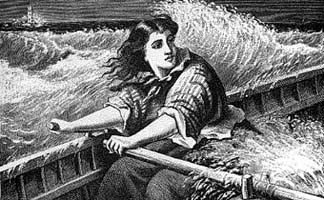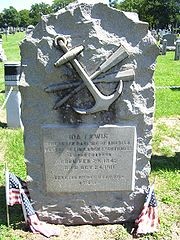MS. IDAWALLEY ZORADA LEWIS

Ms. Idawalley Zorada Lewis was Newport Harbor’s Lime Rock Lighthouse keeper.
Lime Rock Lighthouse became Ida Lewis Lighthouse and in 1928 became the Club house for The Ida Lewis Yacht Club.
Called Ida, she was born in Newport, Rhode Island, in 1842. Her father, Captain Hosea Lewis, was a coast pilot whose health was declining. In 1853 he became the first keeper of nearby Lime Rock beacon on a tiny island a third of a mile from the shore of Newport. Hosea Lewis had been at Lime Rock less than four months when he was stricken by a disabling stroke.
Like many wives and daughters of lighthouse keepers before and after, Ida expanded her domestic duties, now increased by the care of her invalid father and a seriously ill sister, to include the care of the light - filling the lamp with oil at sundown and again at midnight, trimming the wick, polishing the carbon off the reflectors, extinguishing the light at dawn.
Since Lime Rock was completely surrounded by water, the only way to reach the mainland was by boat. In the mid-19th century it was highly unusual for a woman to handle a boat, but Ida, the oldest of four children, rowed her siblings to school every week day and fetched needed supplies from the town. The wooden boat was heavy, but she became very skillful in handling it. (An article in Harper’s Weekly, written after Ida had made several daring rescues, debated whether it was “feminine” for women to row boats, but concluded that none but a “donkey” would consider it “unfeminine” to save lives.) Ida was also reputed to be the best swimmer in all Newport.
Ida and her mother tended the Lime Rock Light for her father from 1857 until 1872, when he died. Her mother was appointed keeper until 1879, although Ida continued to do the keeper’s work. Then Ida received the official appointment and her own salary ($500 a year). She continued at her post until her own death in 1911. On the night of her death the bells on all the vessels anchored in Newport Harbor were tolled in her memory. Because of her many rescues, Ida Lewis became the best-known lighthouse keeper of her day.

During her 39 years on Lime Rock, Ida is credited with saving 18 lives, although unofficial reports suggest the number may have been as high as 25. Ida’s fame spread quickly after the 1869 rescue, for a reporter was sent from the New York Tribune to record her deeds.
Articles also appeared in Harper’s Weekly, Leslie’s magazine, and other leading newspapers. The Life Saving Benevolent Association of New York sent her a silver medal and a check for $100— a substantial sum to a young woman who then earned $600 a year. A parade was held in her honor in Newport on Independence Day, followed by the presentation of a sleek mahogany rowboat with red velvet cushions, gold braid around the gunwales, and gold-plated oarlocks.
When she was 64, Ida became a life beneficiary of the Carnegie Hero Fund, receiving a monthly pension of $30. Tales of Ida Lewis’s skill and courage spread so widely that both President Ulysses S. Grant (1867- 1877) and Vice President Schuyler Colfax went to visit her in 1869. Colfax went out to the lighthouse to meet her, but there are two versions of Ida’s meeting with President Grant. One says that as Grant landed on Lime Rock, he stepped into water and got his feet wet. “I have come to see Ida Lewis,” he remarked, “and to see her I’d get wet up to my armpits if necessary.” The other version states that Ida rowed to shore and was conducted to the President’s carriage to meet him and his wife. Fame brought countless other visitors to the island to stare at Ida. Her wheelchair-bound father entertained himself by counting their numbers often a hundred a day; nine thousand in one summer alone.
 Ida also received numerous gifts, letters, and even proposals of marriage (some of them offering to supply references as to good character). Ida was distressed by all the attention and fended off her many unknown admirers as best she could. Although few details are known, she did marry a Captain William Wilson of Black Rock, Connecticut, in 1870, but they separated after two years. In 1881 the Annual Report of the U.S. Life Saving Service reported that the highest medal awarded by the Life Saving Service had been presented to Mrs. Ida Lewis-Wilson.
Ida also received numerous gifts, letters, and even proposals of marriage (some of them offering to supply references as to good character). Ida was distressed by all the attention and fended off her many unknown admirers as best she could. Although few details are known, she did marry a Captain William Wilson of Black Rock, Connecticut, in 1870, but they separated after two years. In 1881 the Annual Report of the U.S. Life Saving Service reported that the highest medal awarded by the Life Saving Service had been presented to Mrs. Ida Lewis-Wilson.
Ida’s last recorded rescue occurred when she was 63 years old. A close friend, rowing out to the lighthouse, stood up in her boat, lost her balance and fell overboard. Ida, with all the vigor of her past youth, launched a lifeboat and hauled the woman aboard. In 1924 the Rhode Island legislature officially changed the name of Lime Rock to Ida Lewis Rock.
The lighthouse service changed the name of the Lime Rock Lighthouse to the Ida Lewis Lighthouse—the only such honor ever paid to a keeper. In 1995, a new class of Coast Guard buoy tenders was named for Ida Lewis; each succeeding vessel in the class will honor a different lighthouse keeper.
This copyrighted material is excerpted from the book, Women Who Kept the Lights: An Illustrated History of Female Lighthouse Keepers by Mary Louise Clifford and Candace Clifford (Alexandria: Cypress Communications, 2001